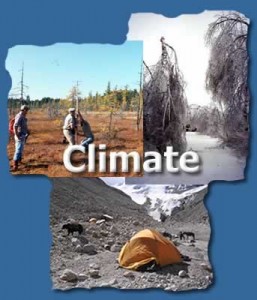Climatology is one of the several branches of physical geography, but it differs from weather in several ways. The term climate implies an  average, or long term record of weather conditions at a certain region. It conveys a generalization of all the recorded weather observations in a given area. Weather conditions are recorded in specifics for any given moment in time: the temperature, percentage of rainfall, and percentage of humidity. Climate on the other hand, is described in more general terms. Humid Equatorial climates, Dry climates, and Cold Polar climates are marked by certain prevailing characteristics that can be mapped such as continuous snow or deserts.
average, or long term record of weather conditions at a certain region. It conveys a generalization of all the recorded weather observations in a given area. Weather conditions are recorded in specifics for any given moment in time: the temperature, percentage of rainfall, and percentage of humidity. Climate on the other hand, is described in more general terms. Humid Equatorial climates, Dry climates, and Cold Polar climates are marked by certain prevailing characteristics that can be mapped such as continuous snow or deserts.
One of the most popular classification systems is the Koppen Climate Classification system, which gives different climates three letters that describe that climate. The Koppen Climate Classification system is comparatively simple and is based on a triad of letter symbols. The first (capital) letter is the critical one; the A climates are humid and tropical; the B climates are very dry; the C climates are humid and mild; the D climates reflect increasing cold; and the E climates mark the polar areas. The first letter is followed by two more letters that further define the climate of that region. The second letter represents and explains the dry season: whether there is or isn’t a dry season, whether it is a short or long dry season, and what season it comes in either a dry winter or a dry summer. The third letter defines the temperature of different seasons either a hot or cool summer or a cold or warm winter. The purpose of the Koppen Climate Classification system is to assist in the realization of the importance of generalization, allowing you to concentrate on the big picture unaffected by less important complexities such as trade winds and jet streams. This methodology persists as a leading model in contemporary geography. In fact in recent years, geography has expanded the search for theoretical principles through the use of laboratory-like abstractions called spatial models. These spatial models are a modern approach to generalization in both physical and human regional geography.
